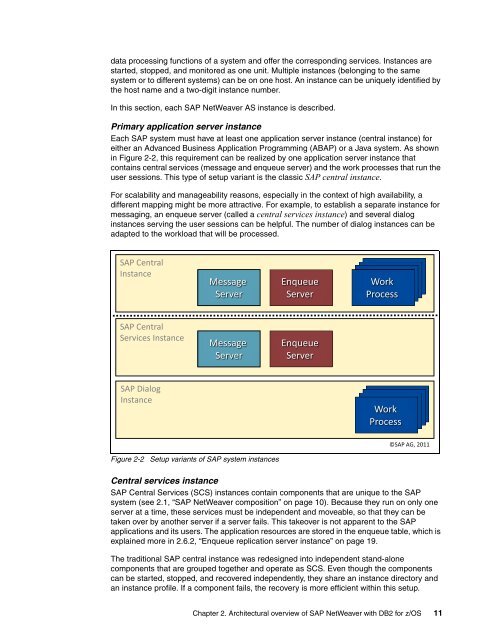Download PDF - IBM Redbooks
Download PDF - IBM Redbooks
Download PDF - IBM Redbooks
Create successful ePaper yourself
Turn your PDF publications into a flip-book with our unique Google optimized e-Paper software.
data processing functions of a system and offer the corresponding services. Instances are<br />
started, stopped, and monitored as one unit. Multiple instances (belonging to the same<br />
system or to different systems) can be on one host. An instance can be uniquely identified by<br />
the host name and a two-digit instance number.<br />
In this section, each SAP NetWeaver AS instance is described.<br />
Primary application server instance<br />
Each SAP system must have at least one application server instance (central instance) for<br />
either an Advanced Business Application Programming (ABAP) or a Java system. As shown<br />
in Figure 2-2, this requirement can be realized by one application server instance that<br />
contains central services (message and enqueue server) and the work processes that run the<br />
user sessions. This type of setup variant is the classic SAP central instance.<br />
For scalability and manageability reasons, especially in the context of high availability, a<br />
different mapping might be more attractive. For example, to establish a separate instance for<br />
messaging, an enqueue server (called a central services instance) and several dialog<br />
instances serving the user sessions can be helpful. The number of dialog instances can be<br />
adapted to the workload that will be processed.<br />
SAP Central<br />
Instance<br />
SAP Central<br />
Services Instance<br />
SAP Dialog<br />
Instance<br />
Message<br />
Server<br />
Message<br />
Server<br />
Figure 2-2 Setup variants of SAP system instances<br />
Enqueue<br />
Server<br />
Enqueue<br />
Server<br />
Work Work<br />
Work<br />
Work<br />
Process<br />
Process<br />
Process<br />
Work Work<br />
Work<br />
Work<br />
Process<br />
Process<br />
Process<br />
©SAP AG, 2011<br />
Central services instance<br />
SAP Central Services (SCS) instances contain components that are unique to the SAP<br />
system (see 2.1, “SAP NetWeaver composition” on page 10). Because they run on only one<br />
server at a time, these services must be independent and moveable, so that they can be<br />
taken over by another server if a server fails. This takeover is not apparent to the SAP<br />
applications and its users. The application resources are stored in the enqueue table, which is<br />
explained more in 2.6.2, “Enqueue replication server instance” on page 19.<br />
The traditional SAP central instance was redesigned into independent stand-alone<br />
components that are grouped together and operate as SCS. Even though the components<br />
can be started, stopped, and recovered independently, they share an instance directory and<br />
an instance profile. If a component fails, the recovery is more efficient within this setup.<br />
Chapter 2. Architectural overview of SAP NetWeaver with DB2 for z/OS 11

















